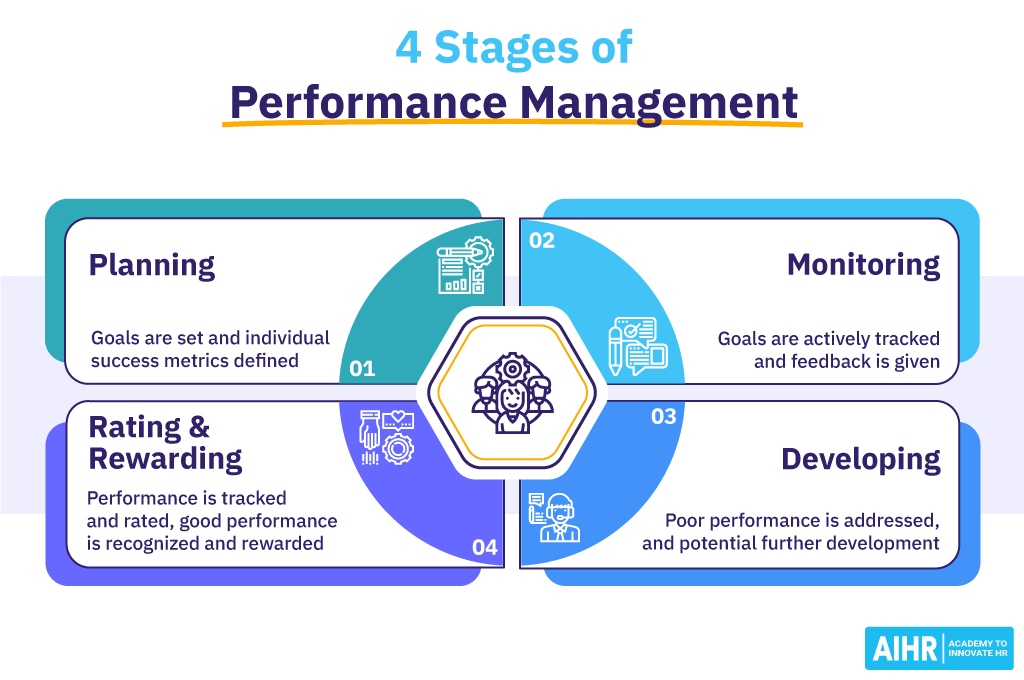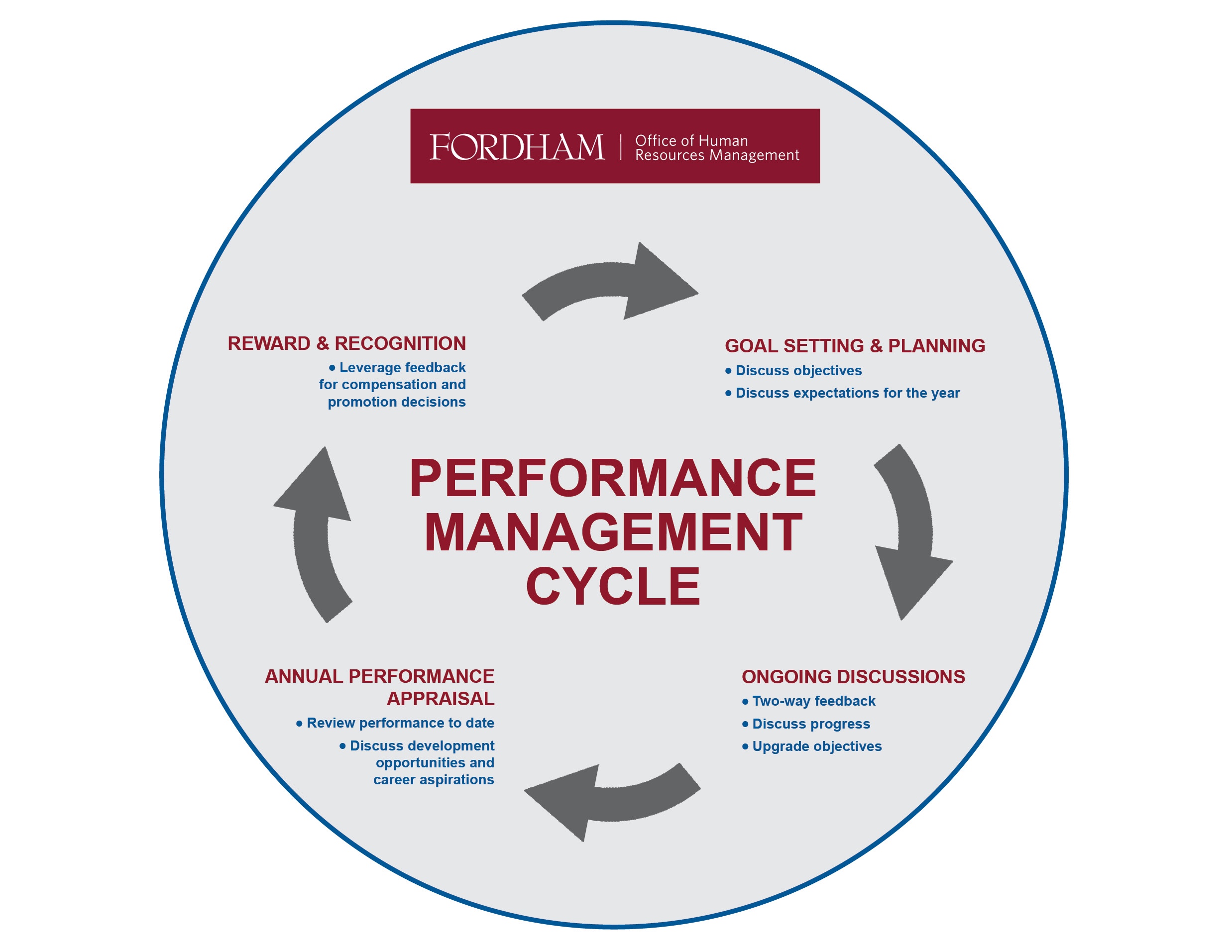How to implement a robust performance management system? It’s the question every forward-thinking leader grapples with. A well-structured system isn’t just about ticking boxes; it’s about fostering growth, boosting productivity, and creating a thriving work environment. This guide dives deep into the essential steps, from defining clear goals and metrics to navigating difficult conversations and leveraging technology for seamless implementation.
Get ready to transform your performance management strategy from reactive to proactive!
We’ll cover everything from setting SMART goals and choosing the right KPIs to mastering feedback techniques and utilizing performance management software. We’ll also explore how to address underperformance effectively, ensuring fairness and consistency throughout the process. By the end, you’ll have a comprehensive roadmap to building a system that empowers your team and drives exceptional results. Let’s get started!
Defining Performance Goals and Metrics

Setting clear, measurable performance goals is the cornerstone of any effective performance management system. Without well-defined objectives, employees lack direction, and organizations struggle to track progress towards strategic aims. This section will Artikel a robust framework for defining both individual and team performance goals, aligning them with overall organizational objectives, and selecting appropriate Key Performance Indicators (KPIs).
Aligning individual and team performance with organizational objectives is crucial for achieving strategic goals. This ensures everyone is working towards a common purpose, maximizing efficiency and minimizing wasted effort. A well-defined system fosters a sense of shared responsibility and accountability, boosting overall productivity and employee engagement.
SMART Goal Framework
The SMART framework provides a structured approach to goal setting, ensuring objectives are Specific, Measurable, Achievable, Relevant, and Time-bound. For individual goals, this might involve quantifiable targets related to sales, project completion, or skill development. Team goals, on the other hand, often focus on collaborative outcomes, such as improved customer satisfaction scores or successful product launches.
For example, a sales representative’s SMART goal might be: “Increase sales revenue by 15% in the next quarter by focusing on acquiring new clients through targeted social media campaigns.” A team goal for a marketing department could be: “Increase website traffic by 20% within six months through optimization and content marketing initiatives, resulting in a 10% increase in lead generation.”
Key Performance Indicators (KPIs) for Different Roles
KPIs are specific metrics used to track progress towards goals. The choice of KPIs depends heavily on the role and responsibilities.
Here are some examples:
| Role | KPI Examples |
|---|---|
| Sales Representative | Sales revenue, conversion rate, average deal size, customer acquisition cost |
| Marketing Manager | Website traffic, lead generation, customer acquisition cost, brand awareness |
| Software Engineer | Number of bugs fixed, code quality score, lines of code written, project completion rate |
| Customer Service Representative | Customer satisfaction score (CSAT), resolution time, first-call resolution rate, customer churn rate |
Aligning Individual Goals with Organizational Objectives
The process of aligning individual goals with organizational objectives typically involves a cascading approach. Starting with high-level strategic objectives, these are broken down into departmental goals, then team goals, and finally, individual goals. Regular communication and feedback are essential to ensure everyone understands their role in achieving the overall vision. This alignment ensures that individual contributions directly contribute to the company’s success.
For instance, a company aiming for a 20% increase in market share might set departmental goals for increased sales, improved product development, and enhanced marketing effectiveness. These would then be translated into individual goals for employees within those departments.
Comparison of Goal-Setting Methodologies
Different methodologies exist for setting goals, each with its own strengths and weaknesses.
| Methodology | Description | Advantages | Disadvantages |
|---|---|---|---|
| OKRs (Objectives and Key Results) | A goal-setting framework that defines ambitious objectives and tracks progress through measurable key results. | Focuses on ambitious goals, promotes transparency and alignment, facilitates progress tracking. | Can be overly ambitious, requires careful planning and monitoring, may not be suitable for all organizations. |
| MBOs (Management by Objectives) | A management system where managers and employees collaboratively set specific, measurable, achievable, relevant, and time-bound objectives. | Promotes employee participation and ownership, clarifies roles and responsibilities, improves performance evaluation. | Can be bureaucratic and time-consuming, may not be suitable for rapidly changing environments, requires strong management commitment. |
Performance Monitoring and Feedback
Regular performance monitoring and feedback are crucial for a thriving performance management system. It’s not just about evaluating employees at the end of a review period; it’s about fostering continuous growth and improvement. This involves establishing a consistent feedback loop, using data to inform decisions, and providing constructive criticism alongside positive reinforcement. A well-structured system ensures employees understand expectations, track their progress, and receive the support they need to succeed.
A robust performance monitoring system hinges on regular check-ins and structured feedback sessions. These sessions provide opportunities for open communication, allowing managers and employees to discuss progress towards goals, address challenges, and plan future actions. The frequency of these check-ins should be tailored to the individual’s role and performance needs, ranging from weekly meetings for new hires to monthly or quarterly reviews for established employees.
The key is consistency and proactive communication.
Regular Performance Check-Ins and Feedback Sessions
Effective performance check-ins should follow a structured approach. Begin by reviewing the pre-established goals and metrics. Then, discuss progress made, highlighting both successes and areas needing improvement. Openly address any roadblocks or challenges the employee might be facing, offering support and guidance. Finally, collaboratively set actionable steps for improvement and schedule the next check-in.
This cyclical process ensures consistent monitoring and allows for timely adjustments.
Effective Feedback Delivery Techniques
Delivering effective feedback requires tact and careful consideration. Positive feedback should be specific and genuine, highlighting the employee’s contributions and their positive impact. Constructive criticism should focus on behaviors and actions, not on the individual’s character. It’s important to frame feedback in a way that is both supportive and actionable, offering concrete suggestions for improvement.
For example, instead of saying “You’re disorganized,” a manager could say, “I’ve noticed that project deadlines have been occasionally missed. Let’s work together to develop a better time management strategy, perhaps using a project management tool.” This approach focuses on the behavior (missed deadlines) and offers a concrete solution (using a project management tool), making the feedback actionable and less personal.
Using Data and Metrics to Track Progress
Data-driven performance management ensures objectivity and transparency. By tracking key performance indicators (KPIs) regularly, managers can gain a clear understanding of employee progress towards their goals. This data provides a factual basis for feedback, moving conversations beyond subjective opinions. For example, sales targets, customer satisfaction scores, or project completion rates can be used to quantitatively assess performance.
Visual representations like charts and graphs can make this data more easily digestible and understandable.
Feedback Form Design
A well-designed feedback form should capture both quantitative and qualitative data. The quantitative section can include metrics like project completion rates, sales figures, or customer satisfaction scores. This allows for objective measurement of performance against pre-defined goals. The qualitative section should allow for open-ended feedback, enabling employees to share their perspectives, challenges, and suggestions for improvement. This section could include questions like, “What are your biggest accomplishments this period?”, “What challenges did you face, and how did you overcome them?”, and “What support do you need to improve your performance?”
Example Feedback Form:
| Metric | Target | Actual | Comments |
|---|---|---|---|
| Sales Revenue | $100,000 | $115,000 | Exceeded target by 15%. Excellent work! |
| Customer Satisfaction | 4.5/5 | 4.2/5 | Slightly below target. Let’s discuss strategies to improve customer interactions. |
In addition to the table above, include a section for open-ended qualitative feedback.
Performance Improvement and Development

A robust performance management system isn’t just about evaluating employees; it’s about fostering their growth and maximizing their potential. Identifying performance issues, understanding their root causes, and implementing targeted development plans are crucial for creating a high-performing and engaged workforce. This section dives into strategies for improving performance and supporting employee development.Performance improvement isn’t a one-size-fits-all solution. It requires a nuanced understanding of individual employee needs and a commitment to providing the right support at the right time.
By addressing performance gaps proactively and fostering a culture of continuous learning, organizations can unlock significant improvements in productivity and employee satisfaction.
Identifying Common Performance Issues and Root Causes
Pinpointing the source of underperformance is the first step towards effective improvement. Common issues include inconsistent work quality, missed deadlines, poor communication, lack of initiative, and difficulty collaborating with colleagues. These problems often stem from various root causes, such as inadequate training, unclear expectations, lack of resources, personal issues, or a mismatch between the employee’s skills and the job requirements.
For example, consistent missed deadlines might indicate a lack of time management skills or an overwhelming workload, while poor communication could stem from inadequate training in communication techniques or a lack of clarity regarding project goals. A thorough analysis, often involving conversations with the employee and their manager, is crucial to accurately diagnose the problem.
Building a robust performance management system requires clear goals aligned with your overall strategy. Successfully navigating this process often hinges on effectively addressing potential roadblocks; understanding how to overcome common challenges in strategic business planning process, as detailed in this insightful article overcoming common challenges in strategic business planning process , is crucial. By proactively addressing these challenges, you lay a solid foundation for a performance management system that truly drives results.
Strategies for Addressing Performance Gaps and Supporting Employee Growth
Once performance issues are identified, tailored strategies must be implemented. This involves creating a structured performance improvement plan (PIP) with clearly defined goals, timelines, and support mechanisms. For example, if an employee consistently misses deadlines, the PIP might include training on time management techniques, providing additional resources, or adjusting their workload. Regular check-ins and feedback are essential to monitor progress and provide ongoing support.
Mentorship programs or assigning a buddy can also be invaluable in providing guidance and fostering a supportive work environment. Remember, the goal is not just to correct the problem but also to empower the employee to develop their skills and grow professionally.
The Role of Training and Development in Improving Performance
Training and development are vital components of any effective performance improvement strategy. Investing in employee training equips them with the necessary skills and knowledge to perform their jobs effectively. This can involve various methods, including workshops, online courses, mentoring, job shadowing, and on-the-job training. Tailoring training to address specific performance gaps identified in the performance review process ensures maximum impact.
For instance, if communication skills are lacking, specialized communication training can significantly improve performance. Regular training opportunities also demonstrate a commitment to employee growth and foster a culture of continuous learning, leading to higher employee retention and overall organizational success.
Performance Improvement Plans and Implementation Strategies, How to implement a robust performance management system
| Plan | Implementation Steps |
|---|---|
| Targeted Skill Development | Identify specific skill gaps; select appropriate training programs (online courses, workshops, mentoring); track progress and assess effectiveness; provide ongoing support and feedback. |
| Workload Management | Analyze current workload; identify tasks that can be delegated or eliminated; provide additional resources or support; implement time management techniques; monitor progress and adjust workload as needed. |
| Improved Communication Training | Assess communication skills; select relevant training (active listening, clear communication, conflict resolution); provide opportunities for practice; monitor improvements and provide feedback. |
| Mentorship Program | Pair employee with experienced mentor; establish clear goals and expectations; schedule regular meetings for guidance and support; track progress and provide feedback. |
System Implementation and Maintenance: How To Implement A Robust Performance Management System

Rolling out a new performance management system is a significant undertaking, requiring careful planning and execution to ensure a smooth transition and maximize employee buy-in. Success hinges on a well-defined implementation strategy, effective communication, and ongoing maintenance to adapt to evolving business needs.Implementing a new performance management system involves several key steps, each crucial for its overall success. A phased approach, allowing for adjustments along the way, is generally recommended over a single, large-scale rollout.
Building a robust performance management system requires clear goals and regular feedback. Crucially, this includes understanding how to effectively leverage technology for communication and monitoring, especially when dealing with remote teams. Learn more about optimizing your remote team’s performance by checking out this helpful guide on how to effectively manage a remote team and boost productivity , which will help you build a more efficient and productive remote workforce, ultimately strengthening your overall performance management strategy.
System Implementation Steps
A structured approach to implementation minimizes disruption and maximizes adoption. This includes detailed planning, thorough training, and a robust communication strategy. Consider these sequential steps:
- Pilot Program: Begin with a small group of volunteers or a specific department to test the system’s functionality and identify potential issues before a full-scale deployment. This allows for iterative improvements based on real-world feedback.
- Training and Support: Provide comprehensive training to all employees on how to use the new system. This should include both online resources and in-person sessions, ensuring everyone feels comfortable navigating the system and understanding its purpose. Ongoing support mechanisms, such as FAQs and dedicated help desks, are essential.
- Data Migration: If transitioning from an older system, carefully migrate existing performance data to the new system, ensuring data integrity and accuracy. This often requires specialized software and expertise to avoid data loss or corruption.
- System Launch: Once the pilot program is successful and training is complete, launch the system across the organization. A staggered rollout, starting with certain departments or teams, can help manage the transition more effectively.
- Monitoring and Evaluation: Continuously monitor system usage and gather feedback from employees to identify areas for improvement. Regular evaluations are key to ensuring the system remains relevant and effective.
Communicating the New System to Employees
Open and transparent communication is vital for gaining employee buy-in. This involves explaining the “why” behind the new system, addressing potential concerns proactively, and providing ample opportunities for feedback.Effective communication strategies include:
- Town Hall Meetings: Conduct meetings to present the new system, answer questions, and address concerns. This creates a forum for open dialogue and builds trust.
- Regular Updates: Provide regular updates on the implementation progress, highlighting milestones achieved and addressing any challenges encountered. This keeps employees informed and engaged.
- Training Materials: Develop comprehensive training materials, including videos, manuals, and FAQs, to ensure employees have the resources they need to understand and use the system effectively.
- Feedback Mechanisms: Establish clear channels for employees to provide feedback on the system, allowing for continuous improvement and addressing any issues promptly.
Ensuring Employee Buy-in and Engagement
Securing employee buy-in requires demonstrating the value of the new system and addressing any resistance. This involves actively soliciting feedback, providing adequate training, and showing how the system benefits both the individual and the organization.Strategies to encourage buy-in include:
- Explain the Benefits: Clearly articulate how the new system will improve the performance management process, making it fairer, more transparent, and more effective for employees. Highlight benefits such as improved goal setting, more frequent feedback, and clearer career development paths.
- Address Concerns: Proactively address any concerns or anxieties employees may have about the new system. This may involve addressing fears of increased scrutiny or changes to existing processes.
- Incentivize Participation: Consider offering incentives for early adoption or active participation in the system. This could include rewards for completing training or providing valuable feedback.
Ongoing Maintenance and Updates
A robust performance management system is not a “set it and forget it” solution. It requires ongoing maintenance and updates to remain effective and relevant. Regular reviews and adjustments are necessary to adapt to changes in the business environment, employee needs, and best practices.Ongoing maintenance involves:
- Regular Audits: Conduct regular audits to ensure the system is functioning correctly and producing accurate data. This helps identify and address any technical issues or data inconsistencies.
- System Updates: Regularly update the system to incorporate new features, improve functionality, and address any bugs or vulnerabilities. This ensures the system remains current and effective.
- Performance Reviews: Regularly review the system’s performance and effectiveness, gathering feedback from employees and managers to identify areas for improvement. This ensures the system remains aligned with organizational goals and employee needs.
Implementation Timeline
A realistic timeline is crucial for successful implementation. This should include key milestones and deadlines, allowing for flexibility to address unforeseen challenges. The timeline will vary depending on the organization’s size and complexity, but a sample timeline might look like this:
| Phase | Activity | Timeline |
|---|---|---|
| Phase 1: Planning & Design | Needs assessment, system selection, design specifications | 1-2 months |
| Phase 2: Development & Testing | System development, pilot program, testing and refinement | 2-3 months |
| Phase 3: Training & Communication | Employee training, communication plan rollout | 1 month |
| Phase 4: Implementation & Launch | Full system rollout, ongoing support | 1 month |
| Phase 5: Monitoring & Evaluation | Performance monitoring, system adjustments, feedback collection | Ongoing |
Addressing Performance Issues
A robust performance management system isn’t just about setting goals and tracking progress; it’s also about proactively addressing performance issues when they arise. Ignoring underperformance can negatively impact team morale, productivity, and ultimately, the organization’s success. A fair and consistent approach to addressing these issues is crucial for maintaining a positive and productive work environment.Addressing underperformance requires a multi-faceted strategy that combines supportive interventions with clear consequences.
It’s about helping employees improve while also protecting the organization’s interests. This involves careful documentation, transparent communication, and a commitment to due process.
Strategies for Addressing Underperformance and Disciplinary Actions
Effective strategies for addressing underperformance go beyond simple reprimands. They involve a structured approach focusing on identifying the root causes of the performance gap, providing targeted support, and setting clear expectations for improvement. This may involve coaching, mentoring, additional training, or adjusting workloads. Disciplinary actions, such as written warnings or performance improvement plans (PIPs), should only be implemented after a thorough investigation and when other interventions have proven unsuccessful.
The severity of the disciplinary action should always be proportionate to the severity of the performance issue. For example, a single instance of minor tardiness might warrant a verbal warning, while consistent failure to meet performance targets could lead to a more formal disciplinary action.
Effective Communication Techniques for Handling Difficult Conversations
Delivering negative feedback can be challenging, but it’s crucial to do so constructively and with empathy. Effective communication involves active listening, focusing on specific behaviors rather than making personal attacks, and offering solutions and support. The “sandwich method”—starting with positive feedback, then delivering constructive criticism, and ending with more positive feedback—can be a useful technique. However, it’s essential to be genuine and avoid manipulating the conversation.
For example, instead of saying, “You’re a great team player, but your reports are often late,” a more effective approach would be, “I appreciate your collaborative spirit, and I’ve noticed your reports have been submitted late on several occasions. Let’s discuss strategies to improve your time management.” Following up with written documentation summarizing the conversation further reinforces the message and provides a record of the discussion.
Importance of Documentation and Due Process in Addressing Performance Issues
Maintaining thorough documentation is paramount throughout the performance management process. This includes records of performance goals, feedback sessions, coaching conversations, and disciplinary actions. Detailed documentation protects both the employee and the organization. It provides evidence of the steps taken to address performance issues and ensures fairness and consistency in the application of disciplinary actions. Due process ensures that employees have the opportunity to understand the concerns, respond to them, and appeal decisions if necessary.
This might involve providing employees with a written warning outlining the performance issues, giving them a reasonable time to improve, and allowing them to present their side of the story before any further actions are taken.
Step-by-Step Process for Handling Performance Improvement Plans and Potential Termination
A Performance Improvement Plan (PIP) is a formal document outlining specific performance goals, the timeline for improvement, and the support provided to the employee. The process typically involves:
- Identifying Performance Gaps: Clearly define the specific areas where the employee is underperforming.
- Setting Measurable Goals: Establish SMART (Specific, Measurable, Achievable, Relevant, Time-bound) goals for improvement.
- Developing an Action Plan: Artikel the steps the employee will take to improve their performance, including training, mentoring, or other support.
- Regular Monitoring and Feedback: Schedule regular meetings to track progress and provide ongoing feedback.
- Review and Evaluation: At the end of the PIP period, evaluate the employee’s progress and determine whether the goals have been met.
If the employee fails to meet the goals Artikeld in the PIP, termination may be considered. This decision should be made after careful consideration and should follow established organizational policies and procedures. The termination process should be handled with sensitivity and respect, ensuring that all legal and ethical requirements are met. Providing outplacement services, such as resume writing assistance or job search support, can demonstrate the organization’s commitment to the employee’s well-being, even in the context of termination.
Technology and Tools
Automating performance management is no longer a luxury; it’s a necessity for modern organizations striving for efficiency and data-driven insights. Leveraging technology streamlines processes, enhances accuracy, and provides valuable data for strategic decision-making, ultimately leading to improved employee performance and overall business success. This section explores the role of technology in optimizing performance management systems.Technology plays a crucial role in automating various aspects of performance management, from goal setting and tracking to feedback delivery and performance review analysis.
Automating these processes reduces administrative overhead, allowing HR professionals and managers to focus on more strategic initiatives, such as employee development and engagement. Furthermore, technology enables the collection and analysis of large datasets, providing a deeper understanding of performance trends and identifying areas for improvement across the organization. This data-driven approach fosters more objective and fair performance evaluations.
Performance Management Software Options
Several software solutions are available to support various aspects of performance management. These range from basic systems for goal tracking to comprehensive platforms that integrate with other HR systems. The choice of software depends on the organization’s size, budget, and specific needs. Careful consideration of features, integration capabilities, and user experience is crucial for successful implementation.
Comparison of Performance Management Software
Choosing the right performance management software requires a thorough evaluation of different options. Key factors to consider include functionality (goal setting, performance reviews, feedback mechanisms, reporting capabilities), ease of use, integration with existing HR systems, scalability, and cost. A comparative analysis will help determine the best fit for the organization’s unique requirements.
| Software | Key Features | Pricing |
|---|---|---|
| BambooHR | Performance reviews, goal setting, feedback tools, 360-degree feedback, reporting and analytics. Integrates with other BambooHR modules. | Subscription-based, tiered pricing based on the number of employees. |
| Workday | Comprehensive performance management suite, including goal management, performance reviews, talent management, and succession planning. Strong integration with other Workday modules. | Enterprise-level solution with significant upfront costs and ongoing subscription fees. Pricing is customized based on needs. |
| Oracle HCM Cloud | Robust performance management capabilities, including goal setting, performance reviews, talent management, and learning management. Integrates with other Oracle HCM modules. | Enterprise-level solution with significant upfront costs and ongoing subscription fees. Pricing is customized based on needs. |
| Zoho People | Performance reviews, goal setting, feedback tools, 360-degree feedback, reporting and analytics. Offers a more affordable option compared to enterprise-level solutions. | Subscription-based, tiered pricing based on the number of employees. |


